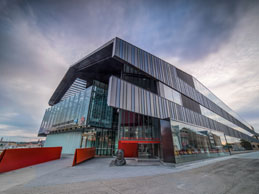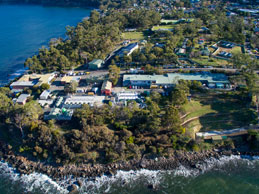Since 2010, IMAS has tripled in size. With a current annual budget of AUD$50 million, IMAS houses 190 staff, and 185 PhD students at two locations across Tasmania, with state-of-the-art research and teaching facilities.

Located at the waterfront in Salamanca, the IMAS Hobart building provides facilities for the operations of IMAS, the Integrated Marine Observing System, the Southern Ocean Observing System, and the Antarctic Climate and Ecosystems CRC.
The building houses five purpose-built state-of-the-art laboratories, a public exhibition area, Waterfront Boardroom, 92 seat lecture theatre, computer lab, and flexible learning spaces. The building has the capacity to house approximately 250 research staff and students.

IMAS Taroona is our dedicated fisheries and aquaculture centre, located on the banks of the Derwent River, just 15 minutes south of Hobart. With direct access to the water, Taroona is the hub for our Fisheries and Aquaculture program, with aquarium facilities, a world-leading Experimental Aquaculture facility, and the Institute's vessel fleet, all located on-site. The building also houses general laboratory, seminar and meeting room facilities.
We have facilities containing seven Climate Controlled rooms (CT-rooms, 0-30°C) for algal culture and experimentation. A specialized CT-room is available for experimentation on atmospheric gas mediated changes in oceanic pH. This research laboratory is certified Quarantine Approved Premises subject to strict Federal Government quarantine protocols (QC 5.2).
As our facilities are structured for research into marine biodiversity and ecology, this laboratory includes CT-rooms for maintaining live zooplankton cultures, as well as wet and dry processing areas. The research laboratory is certified Quarantine Approved Premises subject to strict Federal Government quarantine protocols (QC 5.1).
Our ice core facilities including a -20°C ice core processing facility, large freezer rooms for ice core storage and glaciology experimentation.
IMAS analytical facilities include five positive pressure clean rooms for marine geochemistry analyses, a carbon chemistry laboratory, and general chemistry laboratory. There are also stable isotope mass spectrometry and ion chromatography instruments.
This IMAS laboratory supports research to improve sustainable aquafeed production and refine nutritional requirements of tropical and temperature finfish and invertebrates. Processing (freeze drier) and analytical equipment (kjeldahl protein, soxhlett lipid, ash furnace and bomb calorimeter) provide all major chemical analyses of ingredients, feeds and tissues.
An on-site x-ray and radioactive laboratory allow detailed studies of protein synthesis and other growth processes. The associated Feed Production Laboratory houses a hammermill to prepare ingredients and Californian pellet mill and commercial pasta maker to produce pressed pellets for different fish sizes and species. Several tank systems are used, the largest of which consists of 28 conical 360 litre tanks for rainbow trout and Atlantic salmon. The systems are fitted with computer controlled self-feeders and cameras to allow fish feeding patterns and behaviour to be recorded.
The fish health lab is dedicated to aquatic animal health research and disease investigations. It provides users with specialized and automated histology equipment for all their pathology or health research needs. The laboratory offers an automated Shandon Duplex tissue processor, Shandon Histocentres II and III, two Microm HM340 microtomes, a Hestion TEC29000 Histo-Trimmer and an automated Shandon Linistain GLX. Microscopes combined with digital cameras are also available for image analysis purposes.
This lab is currently the only aquatic animal focused facility in Australia that maintains both radioimmunoassay (RIA) and enzyme-linked immunosorbent-assay (ELISA) both radioimmunoassay (RIA) and enzyme-linked immunosorbent-assay (ELISA) technology for the measurement of various hormones in fish. Research projects conducted in this facility are industry focused and aim to better understand reproductive development, stress physiology and growth performance of cultured fish species. These techniques are being applied to study environmental control of reproduction in fish, impacts of husbandry and environmental stressors in aquaculture, photoperiod manipulation for improved aquaculture production, harvest impacts on post-harvest flesh quality, fish behaviour and fish welfare.
Supporting a wide range of molecular-based research this lab is used for major projects on aquatic animal health and disease, aquaculture nutrition and metabolism, algal and microbial ecology, detection and tracking of introduced and harmful marine pests, fisheries genetics and biology. It is equipped for the analysis of PCR-based molecular markers, DNA-hybridisation and DNA/RNA extraction, quantification and electrophoresis, and includes a gel-imaging and analysis suite.
Dedicated to research on biology and ecology of introduced species, this lab offers the opportunity to broaden general knowledge on biological invasions the threat to marine and coastal ecosystems. Its facilities include a drying oven and muffle furnace, a fume extraction system, stereo and optical microscopes, an underwater digital camera, fridge and freezer. The lab has been recently used for research on community ecology and space utilisation of native and introduced fouling communities and research on biotic and abiotic factors determining distribution and abundance of Petrolisthes elongates in Tasmania.
This unique combination of facilities offers a research space not available at any other university in Australia. It offers a variety of analyses, ranging from basic physical and chemical assessments to product development, shelf-life determination and preservation technology. Recent research projects include the study of the shelf-life optimisation of various species of Australian seafood, and modified atmosphere packaging using a range of different gas mixtures.
This unique combination of facilities offers a research space not available at any other university in Australia. It offers a variety of analyses, ranging from basic physical and chemical assessments to product development, shelf-life determination and preservation technology. Recent research projects include the study of the shelf-life optimisation of various species of Australian seafood, and modified atmosphere packaging using a range of different gas mixtures.
This is a flexible teaching space, holding up to 60 students, and serviced with reticulated ultrapure water (Type 1), filtered/sterilized seawater, nitrogen, compressed gas, and vacuum throughout. Laminar flow cabinets, fume cabinets, drying ovens, and a large-room are also available. Teaching resources include compound microscopes, stereo microscopes, PCR thermal cyclers for DNA amplification, and a broad range of laboratory and field instrumentation. Teaching is enhanced through an audio-visual system connected to microscopes and computers at the lecturer's station. The laboratory space facilitates teaching a range of units from molecular biology to marine ecology.
Our aquarium facilities include: a state-of-the-art seawater treatment for larval marine animals; full larval rearing support facilities including brood stock holding, live feeds, and workshops; six large rooms for work on marine animals with state-of-the-art tank systems for replications (flexible space with 10-20 systems/experiments running at any one time); and, quarantine facilities for work on exotic species.
Our Experimental Aquaculture Facility was constructed in 2015, featuring recirculation technology for research on large marine finfish. The facility consists of:
Primary species to be investigated are rock lobsters, marine finfish, oysters, seahorses, prawns, burramundi and Atlantic salmon.
Our wild fish facilities including raw seawater tank systems for rock lobsters, sharks, octopus, and other marine animals.
IMAS maintains a fleet of small coastal craft that are used for fisheries stock assessment research and to support numerous fisheries, environmental and ecological studies around Tasmania. There are currently 8 research vessels in the fleet ranging in size from 4 to 14m.
Our research partners also have a wide range of vessels – including the RV Investigator operated by the CSIRO which can spend up to 60 days at sea in one voyage.
Supported by 3 dedicated diving support staff, IMAS provides state-of-the-art diving equipment, including closed circuit re-breathers and technology for routine use of nitrox gas, and provides training in scientific diving to professional accreditation standards.
If you would like any other information about our facilities, please contact Operations Manager Kirsten le Mar.